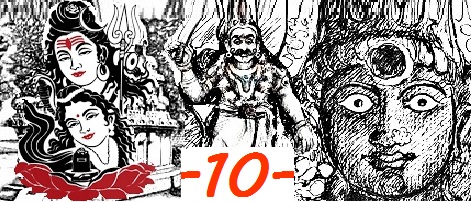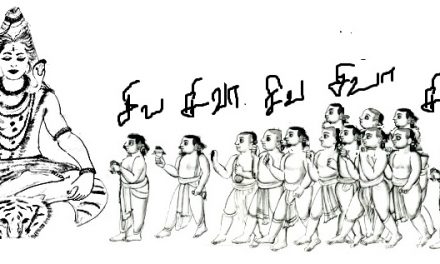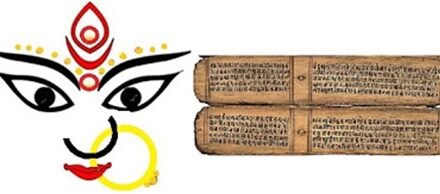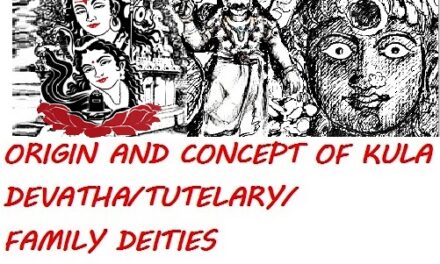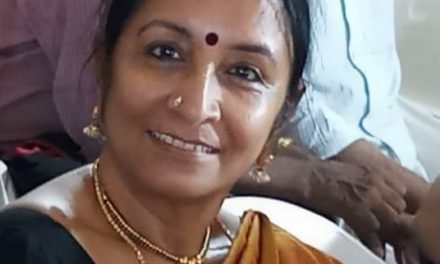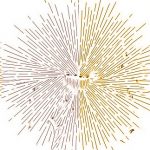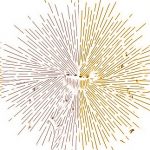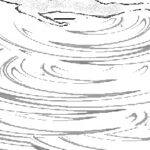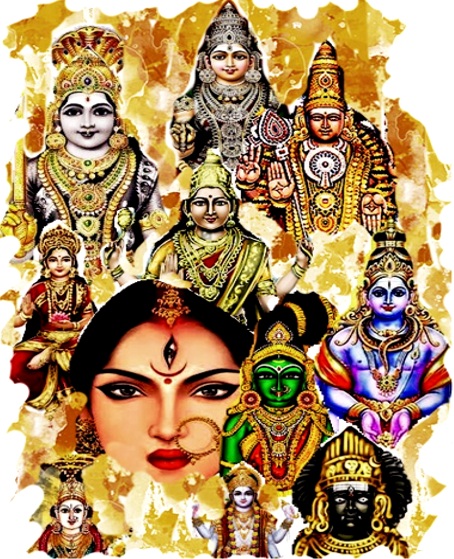 KULA DEVATHA OR TUTELARY/FAMILY DEITIES:
KULA DEVATHA OR TUTELARY/FAMILY DEITIES:
ORIGIN AND CONCEPT -1
-Santhipriya-
1. Kula Devatha or Tutelary/Family deity refers to male or female, God/Goddess, Sub or Demi god or Goddess, whom a family worshipped traditionally through generations. As per Vedic agamic rules, Kula Devatha or Tutelary/Family deity is the first and foremost God to be offered worship in one’s home not only in general but especially during the festive functions, rituals and other important ceremonies conducted/performed at home. This practice has been followed over generations by most of the families to whom their Kula Devatha was known.
2. The worship of Kula devatha was carried forward only by the male members of the family through generations ; their Kula Devatha never changes; however, the Kula Devatha gets changed immediately for the female members, once they get married, since she becomes the property of her husband who may belong to different other Gothra. As per the vedic norms, which is in practice over several centuries, the married women lose the Gothra of her parental side and had to adapt the newer one belonging to her husband’s family. It is believed that Kula Devatha, guide and guard the family members from all hardships and hindrances faced due to karmic deeds; the Kula Devatha believe to protect the family and the succeeding lineage / generations from all odds. Therefore, worship of Kula Devatha should not be ignored as it helps the family lineage grow and take stronger roots. The belief further goes that when we visit the Kula devatha temple, the souls of our forefathers feel happy and bless us with good, prosperous and healthy life.
3. Over long period of time, I attempted to understand the concept of Tutelary/Family-deities, locally called Kulatheivam or Kula Devatha, and literally attempted to analyze the concept of Kula devatha worship by speaking to several people, priests and common folks spread across the urban and rural areas where the practice and worship of Kula Devatha or Tutelary/Family deity is in practice.
4. After my retirement I extensively travelled in rural areas and visited several temples, where I spoke to many folks and priests to understand the concept or the origin of the practice. Wherever and whenever I attended religious functions, there too I talked to the purohitas (chaplain or family priest) and pundits to understand the concept out of curiosity. There was specific reason for my curiosity as half in my life (Parental family), we were worshiping wrong deity as Kula Devatha and came to know of the deity worshipped by our ancestors much later, by mere accident, perhaps when we were destined to know it. Realizing our grave mistake, thereafter we too began to worship the same Kula devatha as worshipped by our ancestors.
5. I also met few learned pundits, especially those in the temples, astrologers, elderly personnel and others who practiced the divinatory art of predicting future using cowries & other materials to cull out some information on this issue, since they were generally approached by the folks whose Kula Devatha was unknown to them. The views I received from them were divergent in nature. I received several interesting queries from several readers across the globe on my earlier small articles posted in my Website (https://pages.santhipriya.com/) in Tamil on Kula Devatha. I attempted clarify many of the unanswered queries to some extent which must have satisfied the readers, but at the same time, I did not leave my pursuit and continued my search to get some more answers to satisfy me.
6. I was excited when two to three unknown elderly people spoke to me on telephone, complemented me for the information that I had provided on Kula Devatha or Tutelary/Family deity and discussed certain other issues on the worship pattern and requested for further clarifications. They suggested that I publish the article in English for wider coverage to enable the younger generation too understand the fading ethos of worship of Kula Devatha unknown to them till then. There were numerous other callers too who complimented me on my articles on Kula Devatha.
7. I would like to briefly quote only two interesting interactions, which I had with two personalities-one a male and the other female member- during my research process. One gentleman from Tirunelveli district in the state of Tamilnadu, a convert to another religious sect, contacted me and after introducing himself, spoke to me at length on how his ancestors got converted into another religion, thereby resulting in him not able to know who his family deity whom his ancestors worshipped ! As he was mentally disturbed due to several family feuds and personal set backs, when he consulted some astrologers, they studied his horoscope and gave divergent views, but all were firm in one point-problem in his life was curse on account of non worship of his Kula devatha. Upon reading one of my articles on Kula Devatha, he said, he contacted me seeking certain clarity and advice on how to recommence the worship of his Kula Devatha and how to find out who his unknown Kula Devatha was.
8. Earlier some of his friends advised him to reach out to predictive astrologers or other or soothsayers to find out who his Kula Devatha or Tutelary/Family deity was; some others suggested exploring other means like approaching those who spoke through mediums- spirits; but he ignored all their suggestion and contacted me to seek my opinion.
9. From my experience I have found out that even experienced Astrologers, soothsayers, those who predict one’s future and problems after speaking with the spirits of their ancestors and Nadi astrology (predicting with the finger print of left hand thumb impression) can not exactly predict the name of the Kula Devatha and accurate place where one’s Kula Devatha or Tutelary/Family deity resided; they can only broadly guide one, but can not pin pointedly tell either the name of the deity or the name of the temple where the deity -Kula Devatha- resided; but, the astrologers may not agree with me. I am of the strong opinion that even the well experienced astrologer can only predict the Kula Devatha to be either male or female deity and further reveal whether the female deity was Amman or Mariamman or Grama devatha provided they were expert in prediction; on the other hand, only elders in the lineage can throw light on the actual deity whom their ancestors worshipped as Kula Devatha.
10. With these convictions and some personal experience and knowledge in this matter, I discouraged the unknown stranger friend from undertaking any such multi varied exercises and instead first try to trace out his Kula Devata (family deity) by asking elders in his family, especially those on his father’s or mother’s side, as they may know which deity their family worshipped. Also, look for temples in his ancestral village or places where family rituals like Mundan (hair shaving ceremony) or post-wedding ceremonies were held. He took my advice in the right spirit and began searching for the relatives of his forefathers to find out their Kula Devatha or Tutelary/Family deity.
11. Few days later he contacted me again by phone to thank me and informed me that he managed to get some information from one of the relatives from his forefather’s lineage to learn the name of the deity whom their forefathers worshipped. He was pleasantly surprised when he was told that the shrine of the deity whom his ancestors had worshipped lay just outside the compound wall of the same religious centre of their converted religion.
12. He was still amazed that he had walked past the shrine many times, which was very small roadside shrine, touching the boundary wall of their new (converted) religious centre. His relative showed him the small structure inside which was seated a Mariamman group of deity (I have forgotten the name mentioned by him), who was worshipped by their ancestors and discontinued the worship after they got converted into the new religion for various social reasons which prevailed in those days.
13. His family deity was found seated inside the small dilapidated brick structure touching the wall of the converted religious centre. Once he got the full facts, he began to offer worship to the Kula Devatha or Tutelary/Family deity seated inside the brick structure in addition to offering worship in the converted religion which he could not abandon due to social reasons.
14. The gentleman confessed that after he began worshiping his Kula Devatha or Tutelary/Family deity, he felt as if his mental agony began to recede and several of his family disputes which mentally bothered him started disappearing slowly. He sought some more clarification on Kula Devatha and again profusely thanked me for my advice. After few more days he contacted me again to tell that following his decision few more family members of him too began to offer worship to their original family deity- Mariamman . When he sought my advice as to how he can render some service to the shrine of his Kula Devatha, I suggested that as token of his obeisance and prayer, he could start meeting the expenditure of oil used for lighting up the oil lamp kept inside the shrine; without hesitation he happily agreed to do it.
15. The second close interaction was with an unknown lady from Bangalore who contacted me sometime in Feb 2019 by Email followed by telephonic call. After exchanging pleasantries, she spoke to me at length on the ordeals faced by her as if I was closely associated with her for many years. She said that contacted me after reading my article on Kula Devatha. She mentioned that she could not offer worship to her unknown grama Devatha called Tanjamma along with her Kula Devatha or Tutelary/Family deity Ayyanaar since her husband was disinterested in finding the temple where her grama devatha – Goddess Tanjamma- was enshrined and sought my help to find out where the temple of Goddess Tanjamma existed around Kanchipuram near Chennai in Tamilnadu. As per the practice of her family they had to offer worship to both male deity Ayyanaar who was their primary Kula Devatha and female grama devatha Tanjamma who was their secondary Kula Devatha. Though she gave me few hints on the deity worshipped by her ancestors, she could not tell the exact place where some of her ancestors lived in and around Kanchipuram near Chennai in Tamilnadu. Her attempt to find where Tanjamma temple existed around Kanchipuram failed ; hence she approach me seeking help.
16. Since I was nether a detective, nor an astrologer to find out the lost articles, I advised her to read my article on how to find out the Kula Devatha as practiced for many years by our elders provided she believed in it. I wrote the article in my Website Santhipriya.com in 2018 (https://santhipriya.com/2018/04/ritual-to-find-out-the-tutelary-deity.html ). I told her that this practice has been followed by our ancestors for many years in the past. She promised to begin practicing it from next day.
17. She was eager to find out her Kula Devatha or Tutelary/Family deity temple since some astrologers had indicated to her that discontinuing the grama devatha deity worship was the main reason for her current predicaments. She was suffering from terminal cancer and wanted to offer worship Goddess Tanjamma before anything could happen to her. With the inputs I received from her, I started searching for Tanjamma temples extensively and could come up only with two or three places as the possible location of the temple. Still, the information was insufficient to locate the exact location of the temple where her grama Devatha resided from among those two to three Tanjamma temples which too were in Andhra Pradesh. I failed to locate the site of Tanjamma in or around Kancheepuram.
18. Days passed and one day she suddenly rang me up to inform me that she did perform the ritual as suggested by me and got clue of her Kula Devatha by luck. One of the Car repair works in Jayanagar showed signboard as Tanjamma repair works. Out of curiosity when she interacted with the owner of the Car repair shop, she got clue on her grama devatha’s temple. Based on the clues from them, and the name and places of three Tanjamma temples which I had mentioned to her, I published her story under the title ‘In search of Kula devatha- a true story- in my website in the month of March, 2019 withholding her name and whereabouts under the title ‘In search of Kulatheivam Family deity – a true story’.
19. Strangely after the story appeared in my website, there were few more callers seeking information on the very same Goddess Tanjamma who was their Kula Devatha or Tutelary/Family deity and the temples where the deity had been installed. They approached me because the details on those temples were not available in any of the web sites.
20. My interaction with some of the Tanjamma devotees revealed that the same deity in the same name was worshipped by different sects in two to three different other temples in faraway places. Each group or sects offered worship to the same deity in the same name, but only in the specific temples where their ancestors had offered worship. But I could not get the addresses of the temple as they were not separate shrines of Goddess Tanjamma. She was seated in different other temples in separate sanctums.
21. However, with clues provided by one of them which I passed on the information to the lady. Later she said she succeeded in locating the place of her Grama Devatha (her secondary Kula Devatha) which was in a remote place in a village called Adukkamporai, in Vellore near Kanchipuram in Tamilnadu. She said along with Tanjamma, a Grahma devatha called Selliamma was also there in the shrine. The lady profusely thanked me for my effort. Thereafter for many days I did not contact her; however, after few months when I called her to find out the address and photo of the deity, I was informed by her husband that she had already passed away few weeks earlier. I felt sad. Therefore, in the year 2020 I removed her story published in my website in March, 2019 (Link https://santhipriya.com/2019/03/tanjamma-kuladevathai.html) to conceal the identity of the late soul.
22. I was thrilled to face many such interactions through mail, telephonic talk etc including calls from foreign countries who wanted some advice on their Kula Devatha or Tutelary/Family deities.
23. Since I continued to receive queries from many callers on how to find out the unknown Kula Devatha or Tutelary/Family deity, based on the centuries old custom and practice which was not widely known to the folks, I published the english translation of my Tamil article on how to find out the unknown Kula Devatha or Tutelary/Family deity, published in the year 2018 (Original link : https://santhipriya.com/2018/04/குல-தெய்வத்தை-எப்படி-அடை.html) . The English version appeared in my website in the year 2020 (Link: https://santhipriya.com/2020/10/family-deity-kulatheivam-how-to-find-out.html ).
24. From the inputs I received, I came to know that some of the folks were benefited by my article and were able to find out their Kula Devatha or Tutelary/Family deity by the practice published in my website and thanked me for the article.
25. The unique experience compelled me to search for more material for this researched article. I began collecting information on:
• How were the divines created?
• How did the concept of worship of the divines and worship of Kula Devatha or Tutelary/Family deity emerge?
• How were the Kula Devatha or Tutelary/Family deity adapted by families?
• Does specific ritual exist through which one can adapt newer Tutelary/Family deity or Kula Devatha?
• How could there be so many Tutelary/Family deity or Kula Devathas?
• The newer family deities when emerge as Kula Devatha or Tutelary/Family deity, from where do they derive divine powers?
• Can one change their Kula Devatha or Tutelary/Family deity at will?
26. To those who contacted me, I promised to write a detailed article on the origin of Kula Devatha or Tutelary/Family deity covering all their queries to the best of my knowledge. As I mentioned in previous paras the inputs in my article were based on the discussions I had with various temple pundits, some persons of deeper spiritual mind, read in several sources, word of mouth stories which flowed through generations, heard in discourses, folk lores, discussions with few individual elders at various periods of time and other materials in web.
27. Lot of theories and debates float around the origin of Kula Devatha or Tutelary/Family deity. If one read several texts of Puranas and epics they can find the reference of divine worship during the Vedic period which led to the worship of Kula Devatha or Tutelary/Family deity.
28. As per the folk lore of Nalgheda temple in Sharjapur district in Ujjain, Madhya Pradesh, on the advice of Lord Krishna, Yudhishthira, one of the Pandava brothers came to Bagalakmukhi Devi temple in Nalgheda and offered prayers to the Devi for victory in the Mahabharata war. Lord krishna reportedly told Pandava brothers that Goddess Bagalakmukhi Devi was their family deity (Read the story of the devi in link: https://santhipriya.com/2012/05/ujjain-bagalamuki-temple.html) which confirms that the worship of Kula Devatha or Tutelary/Family deity existed even during the period the Mahabharata war was enacted. Mahabharata war may have occurred sometime between 3500 years or 7000 years. Some of the puranic stories states that Lord Krishna’s disappearance from the universe occurred during the same period.
29. Reading the texts of epics, Puranas and other scriptures, it is evident that the concept of divine worship including the Kula Devatha or Tutelary/Family deity did exist during the vedic period. For example, there are references to Brahmins in ancient texts such as Ramayana, Mahabharata, Bhagavatam, Rig Veda and Bhavishya Puranas which have been written during the vedic period of time. One sect in the Brahmins who were predominant in the vedic period were Saraswat Brahmins who resided in the banks of River Saraswathi. Those Saraswat Brahmins are known to belong to Gothra of the seven Rishis first created by Brahma. Traditionally it is said that each Kula or descendants of a family belonged to a distinctive Gothra and each Gothra represented one of the seven Saptha Rishis. The Saraswat Brahmins who perhaps have ten Gothra in the name of ten Maharishis have the long history and conventional practice of worshiping eight specific Kula Devadas, which further indicates that the concept of Kula Devatha worship prevailed even in vedic period. This will clarify how the Kula Devatha or Tutelary/Family deity concept has been adapted by families. There are several historical stories on Saraswat Brahmins which strengthens the belief that the family deity worship existed in their period of time.
30. The practice of Kula Devatha or Tutelary/Family deity worship surfaced beginning from vedic period when there were no castes or religion and everyone alike worshipped the same form of divines. In the greatest epics like Ramayana and Mahabharata too there was no reference on castes and religion like Hindus, non-Hindus, but references of human divide, classifying the society into four varnas or classes – based on their capabilities to perform certain functions existed.
31. What exactly is a deity or divine? It is a supernatural being in some form or appearance, possessed with supernatural divine powers and who is worshipped by people, who believe that it controls or exerts force over all aspects of the world. While in Hinduism, the deity is referred as Devatha, the Europeans coined it as Deity which is a Latin word- Deus, meaning God. ‘Deva’ in Sanskrit too refers to divine and ‘Kula’, the sect or generation.
32. The Hindu theistic believe in various paths of worship such as henotheism (belief in single supreme God without disputing existence of other divine forces), monotheism (believe that only one supreme God exist), polytheism (belief in pantheon of divines, both male and female), panentheism (belief that divine exists everywhere in the universe, accessible to everyone), or monism (Only one God which is masculine and eternal) for spiritual enlightenment and to safeguard families for progress in life. The worship of Kula Devatha or Tutelary/Family deity concept comes under Polytheism and Panentheism. Kula devatha is specific deity for each family.
33. Since many centuries every family/sect/lineage/generation had their own chosen deity of either male of female divine forms. For generations each family tree worshipped a specific deity and thus they became their Kula Devatha or Tutelary/Family deity; there was always a bond between the family and the specific deity and hence it became custom for the family members to always offer prayers to the specific deity in the name of Kula Devatha or Tutelary/Family deity immediately after invoking Lord Ganesha, who is the prime divine, the remover of obstacles. Thus, in any rituals or ceremonies performed by the family, prayers to divines in the ritual or ceremony follows only after Lord Ganesha is invoked and immediately offering prayers to Kula Devatha. All other rituals in the ceremonies begin subsequently after invoking Lord Ganesha and Kula Devatha. The head of each family used to be referred as ‘Glue of the family’ and who hold the family together to maintain strong bonds between family members.
34. There goes belief that any function, ceremonies, rituals or poojas performed will give no fruitful result unless the Kula Devatha or Tutelary/Family deity is invoked or worshipped immediately after invoking Lord Ganesha.
35. Most of the Kula Devatha or Tutelary/Family deity temples are normally found in the family’s ancestral village/towns because several hundred years ago most of the folks lived in the villages as a cluster group or settled together along with their relatives around. Those places used to be called as Agraharams by the Brahmins community.
36. Similarly in each state in India, in many villages there are localities or settlements where certain castes or communities historically settled together, forming distinct neighborhoods that serve similar purposes as Agraharams, focusing on community life and sharing cultural practices. Each families had their own Kula Devatha or Tutelary/Family deity and temples in village level. The specific deity worshipped by them as a Kula Devatha varied depending on the lineage and their traditions.
37. In the Vedic period the father was head of each family and none reversed his dictum nor felt ashamed of toeing their father’s line. It was priority to maintain the togetherness of the families, and those family members who disrespected or revolted against the unity of the family were either discarded or condemned by other family members. In the past, everyone in the family-right from grand parents to great grandson- lived under the same roof, or if the members were more and could not live in a smaller house, some of the family members along with their kids lived in nearby neighborhood so that on occasions of important events, all of them could join together and celebrate the function as one unified family. What the practice prevailed then was that after the demise of father, either his wife or the first son in that family automatically gained the status of family head.
38. From the great, great grandfather to the youngest great grandson in the lineage, everyone worshipped specific deity in a specific temple of their village/city which became their Kula Devatha or Tutelary/Family deity. On important occasions all of them together went to the temple and worshiped their Kula Devatha or Tutelary/Family deity. The practice continued in each of the family clans through the lineage members. This is how the concept of worshiping the Kula Devatha or Tutelary/Family deity of the first generation flew down amongst the members of their families.
39. The majority of present-day folks lived in remote villages along with their family members in cluster groups, because most of them were engaged either in the agricultural activities or as laborers or in the profession such as priests or pundits attending to the rituals and functions performed by Kingdoms in various areas.
40. In those era, none of the townships were well developed, hence, the villages consisted of clusters of various castes and creed; however, everyone lived as a group in their region and together participated in each one of the functions or rituals held in their villages.
41. In the initial era when the settlements in remote villages appeared, each one of the family members began to show respect to some stones erected on the spots where dead pet animals were buried, spots where those died in the families were buried or spots where strange noises were made by different animals or birds. They were believed as wandering areas of unknown souls. Over the years the stones erected on them became unknown divine and offered worship.
42. Years further rolled on, the folks began to erect different shaped stones or stones carved into some images by artisan in their village on those spots as stated in previous para, which began to be considered as sacred places. Thus, the concept of giving some forms or appearance to the stones when surfaced, those spots subsequently began to be called as deities and offer of worship began. Over several years subsequently, those sacred places became their worship places and the images carved out on the stones or statues installed there became Kula Devatha or Tutelary/Family deity or as their Ishta Devatha for worship.
43. This is how the unknown places and spots in the villages turned into places of worship, where carved out imaged stones or statues made of clay or mud were installed and named as guardian or village deities; later they were housed either in the open space without roof or under roof covered with woven fronds of either coconut trees or palm trees.
44. In the above background, it is safe to assume that the Kula Devatha or Tutelary/Family deity concept emerged from the worship of deities whose numerous idols and statues were found erected in the villages and venerated as part of the folk tradition in villages. One cannot find even one village without a statue of some deities addressed in many names, few among them as Aiyanar, Muneswaran, Karuppaswamy, and various forms of Amman (goddesses) like Mariamman, Renuga Devi, Ellamma, and Pachai Amman, Pothuraju, Sastha, Gangamma, Polamma, and Sunkalamma, Shastha, Kathavarayan, sapthakanniga, Maheswaramma, Pidariyamman, Maha Kali etc etc. The list has numerous such names.
45. The names of divines vary between south and north India where Mariamman is called as Seethalamma . To my knowledge in northern India, the concept of Kula Devatha does not exist and they offer prayers in the name of Ishta Devatha or Grama Devatha. The specific deities whom the North Indians worship, are often tied to their caste, community, or geographical region. Those deities may not be as formally recognized as Kula Devathas, but perform roles in terms of familial and community identity. However, in North India, some of the sects do worship incarnations of goddess Parvati called by different names, Lord Shiva, Snake gods and Goddess Durga, Kali, Lord Hanuman, Lord Krishna, and various other deities as their Kula Devatha.
46. This is the prime reason why most of the Kula Devatha or Tutelary/Family deity of one’s generation is found in one’s ancestral village. It is also interesting to note that out of those deities, over 90 % were Village guardian deities or Grama devathas – which were either second or third line of divines in the hierarchy of divines.
47. Different divisions of divines are explained in one of the later paras.
48. Over period of time, as migration from villages to towns began, the members of those families who relocated their place of stay to newer places used to visit their native villages whenever possible and continued offering prayers to their Kula Devatha or Tutelary/Family deity in their ancestral home land.
49. The elders always maintained that without the blessings of ones’ Kula Devatha or Tutelary/Family deity, nothing good will happen in the family, even if they offered prayers to any one of the Ishta Devathas (favorite god) or the Gurus {Head of the mutt (monastery)} to which the family is attached.
50. It was custom to the families in south India, who for some reason or the other did not know their Kula Devatha or Tutelary/Family deity, adopted either Lord Vaidyanathaswamy of Vaitheeswaran temple or Lord Venkatachalapathi of Tirupathi as their Kula Devatha or Tutelary/Family deity.
51. Their belief stemmed from the fact that Lord Venkateswara, an aspect of Vishnu is encompassed with the power of Trimurtis – Brahma, Vishnu and Shiva -besides the power of Shakthi, the female divine energy of ‘Supreme’ and he appears in whatever form the devotees may want to worship and therefore is the root of all divines, quite possibly their Kula Devatha too would be one amongst them.
52. Similar is the case of Lord Vaitheeswaran, who is Shiva in the form of a Shiva Ling. The Shiva Ling is believed to be embodiment of Shiva and Sakthi – One half of Shiva Ling is supposed to be the male divine energy of ‘Supreme’ who created the cosmic and the other half is that of Shakthi- both embodiment of all divines. Brahma and Vishnu are seated below holding them over their head.

53. One cannot abruptly change their Kula Devatha or Tutelary/Family deity or choose another at will abandoning what their forefathers had worshipped through generations. Only by the act of nature, the worship of the specific Kula Devatha or Tutelary/Family deity chain gets broken midway when the lineages had no male members or no children at all or some had only female children in the lineages. See chart attached below to understand it.
54. The worship of Kuladevatha/Tutelary deities continues in a family through male members only. Since the female gets married and goes to another house, her gothra changes to that of their husbands; her Kula Devatha also becomes another deity worshipped by her husband’s family, putting an end to the worship of her parental Kuladevatha.
55. This is illustrated by the example shown in the picture below. For example, let us assume that Mariamman is the Kuladevatha/Tutelary deity to six families- all different groups.
• Family No -1: Suppose there are six children in a family- the first being male and the rest female- Mariamman continues to be worshipped as Kuladevatha/Tutelary deity, provided the first son bore male members as children. However, if the son bore no children, or he has demised, or he gets only female children, then Mariamman cease to be Kula Devatha for their family and their generation with the demise of him as he has male children to continue her worship. Mariamman will remain Kula Devatha to the rest of the five female members of that family till they remain unmarried. The moment they get married, their Kula Devatha changes to that of their husband’ side.
• Family No -2: Same logic applies as above. Mariamman remain Kula Devatha even after sixth member gets married in that family. If the sixth member too bore male child, then the worship of Mariamman as Kula Devatha will further continue through their 7th, 8th and 9th generation provided the male members bore male children in their family. However, if none in the six members of the family possessed male child, the worship of Mariamman as Kula Devatha ceases for the generation of family No 2, after the death of the sixth member in that family.
• Family No -3: Same logic applies as above. Mariamman will remain Kula Devatha even after 6th generation and onwards, provided the 4th member bore male children or else it ceases with the demise of the 4th member. The worship of Mariamman as Kula devatha cease to exist for the female members in that family once they get married.
• Family No -4: Same logic applies as above. Mariamman remain Kula Devatha even for the families of fourth and fifth members and will continue to 7th, 8th 9th and so on provided they bore male children in their family. Otherwise, in the family tree of No 4, Mariamman worship as Kula Devatha cease to exist with the demise of sixth member if none -4th, 5th and 6th family members had no male child.
• Family No -5: Mariamman remain Kula Devatha even after sixth generation member and will continue to 7th, 8th 9th and so on provided they bore male children in that generation.
• Family No -6: Mariamman worship as Kula Devatha breaks for the generation of Family No-6, from the first member itself (one by one in the family tree) all the six members in that family tree of No 6 gets married.
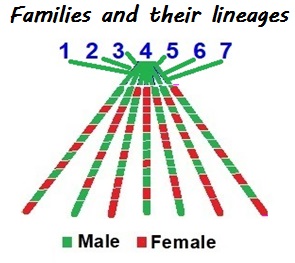
56. As already indicated earlier, the Kula Devatha worship has not started in recent centuries, but was five to seven thousand years old. Now let us see how the deities got some form or appearance. To understand this, we need to go from the stage of creation of cosmic in brief. Unfortunately, the principle and canon of creation flew through word-of-mouth stories or stories as found in vedic puranas and Itihasas. They were all carried forward by the preachers and teachers, or transcripts from spiritual masters, lectures of seers and sages etc including divine prophets and messengers over the past several thousands of years.
57. Stories on the birth of Cosmic and appearance of divines were carried forward by word-of-mouth stories only as major texts of original Rig Veda and other important puranic texts of pre and post Vedic period, reportedly kept scribbled on palm tree leaves remain untraceable till date or believed to have been destroyed by nature, so opine the spiritual masters. Hence many of the texts belonging to the Vedic period which contained Kula Devatha worship too remained as word-of-mouth stories. However, since the same texts have also been reportedly preached to the divine sages by the divines themselves on many occasions, they may have ensured that the stories got percolated to the folks of the land by word-of-mouth stories and teachings.
58. Some of the spiritual organizations such as Brahmakumari Samaj, Gayathri Parivar, Dattathreya Parivar, Digambara and life stories of several Seers, Sadhus and Sannyasins hold these views strongly. It is also reportedly mentioned in a text called ‘Rahasya Sthuthi’ meaning secret doctrine that the principle and canon of creation has been narrated by Lord Vishnu himself to Sage Narada, but unfortunately the same text is also not available and floats only by word-of-mouth stories and folk tales.
59. According to the Puranic texts and beliefs, ever pervading ‘Supreme’, unknown, invisible super power, when decided to create Cosmic, produced out of his own body, a land consisting of water and in that he threw some seed (the seed referring to creation) which turned in to be a Golden Egg. After carefully analysing all aspects for over a year , he broke the Egg into two pieces to convert them as Earth and Heaven and in between them kept empty space referring it as Aakasa (Ref: Manusmrithi Verses 1.8 to 1.13).
60. In Tripura Ragasya in Chapter 22 the origin of the universe has been described briefly. It states that The Supreme who was ‘she’ alone manifested vast cosmic followed by the release of three aspects of energies called Brahma, Vishnu and Rudra. In the form of Brahma, he manifested cores and crores of creatures with several aspects which included the static and non static beings and humans- several with female and male energies. In the form of Vishnu, he began to protect what Brahma has created. In the form of Rudra, he himself becomes destroyer of those evils from the endless ones created by Brahma and protected by Vishnu.
61. The act of releasing the Cosmic through an egg by the Supreme is perhaps what is described by the scientists as Big Bang Theory. If we believe the Big Bang theory, Cosmic or the Universe was created before 13.7 or 13.8 billion years while the Vedic scientists believe that it may have been much older than believed in the Big Bang theory. Whatever it be, the evolution have been gradual in the cosmic and it took billions of years to convert the space manifested by the ‘Supreme’ into livable land.
62. What was the condition of the earth when the land emerged from ‘Supreme’ and how was it activated? The most accepted Big Bang theory is the leading explanation for how the universe began. It says that the universe as we know it today started with an ‘infinitely hot and dense single point’ that inflated and stretched.
63. The ‘infinitely hot and dense single point’ referred to by the Big Bang theory might have been Sun who may have been released by ‘Supreme’ along with the Cosmic, but to remain in invisible form. Most scientists agree that the atmosphere and the ocean accumulated gradually over millions and millions of years with the continual degassing of the earth’s interior surface which was found filled with complete gas, which was water.
64. According to the theory floated by the scientists, the universe of the present day has developed in four to five stages from the time the cosmic was created. Initially when the cosmic was created, it was filled with densely covered dust particles blocking visibility, filled with gas, molten rocks, and appeared completely dark without any light. Slowly over the years as the dust particles settled down, universe began to receive some form of light freed of darkness and the land began to expand. The scientists pointed out that around 4.5 billion years ago, no liquid water was present anywhere on Earth. The Earth was so hot that the rocks were molten (they were liquid).
65. Scientists opined that the water was present in the form of gas until the Earth cooled down, the water vapor condensed and rained back onto the surface of the Earth for millions of years which turned into ocean. Spiritually speaking the earth may have been cooled off by the invisible Moon and Vayu who may have also been released by ‘Supreme’ while Sun was released as they were responsible for the nature’s act. As the water drained into the great hollows in the Earth’s surface, the primeval ocean came into existence to become a huge ocean on land in the universe. The one who caused the rain, thunder and lightening in the form of volcanic eruptions was again the invisible Lord Varuna who would have also been created by ‘Supreme’. In addition to Sun, Moon, Varuna and Vayu, one other created by ‘Supreme’ may have been Lord Indira who controlled the sky, lightning, weather, thunder, storms, rains, river flows etc as leader of heaven in tandem with other Lords. But all their acts may have remained in the background only for the purpose of molding the earth released by ‘Supreme’.
66. ‘Supreme’ was well aware that it would take several billions of years to get the Land and Ocean ready in place to make them livable as the Earth and the Ocean (water) were the most needed planes for the humans or the creatures to live and survive. Hence after the Earth was brought out from inside the body of invisible ‘Supreme’, next most important need was creation of Ocean (water) and few important divines which controlled the nature. Hence invisible Lords like Sun, Moon, Varuna and Vayu along with Lord Indira may have been released by him till the land and ocean were made ready and then they may have been absorbed back by the Supreme to manifest afresh through prime divines.
67. The scientific revelations support the theory that it has taken more than 13 billion years for the Earth and Ocean to settle down in the manner stated in pre paras to accommodate the living beings and hence ‘Supreme’ waited that long for the release of divines and other creatures. According to scientific studies 55 to 60 million years ago initial souls released by Brahma may have taken the shape of the primates which were in the form of 15-20 species from which some kind of human forms surfaced six to eight million years ago.
68. The spiritual masters believe that the earth consisting of vast sea and moving plane called Land imbibed with the qualities of four Yugas were actually lying inactive within the energies of ‘Supreme’ and they were brought out by ‘Supreme’ and activated before he began the creation through Brahma. The scientists support this belief when they say “For something to exist, there must be material or a component available, and for them (material or component) to be available, there must be something else available. Where did the material come from that created the Big Bang, and what happened in the first instance to create that material?” (Ref: https://www.bbc.com/future/article/20220105-what-existed-before-the-big-bang). The unanswered question to scientists ‘where did the material come from that created the Big Bang’ points out spiritually to invisible ‘Supreme’.
69. The universe churns into four yugas and ends at the end of the fourth when the Supreme annihilates everything by means of deluge and recreates everything afresh. In puranas though the Supreme is stated as ‘He’ and in some as ‘She , the basic manifestation of Brahma, Vishnu and Rudra have not been disputed greatly.
70. One may tend ask as to why we should discuss about the creation of Cosmic as our subject matter is Kula Devatha or Tutelary/Family deities. Unless a portion of the aspects of creation is read and understood, the appearance and role of divines who had manifested from whom several divines including Kula Devatha or Tutelary/Family deities manifested before the humans appeared would have remained unknown.
71. After the Cosmic with Earth and Ocean were created by ‘Supreme’, it may have taken something like 13.699 billion years for the universe to expand and expand to get ready with vital aspects like water in the Ocean, rivers and light to accommodate the souls, floating movable – immovable subjects, male and female souls and all other species of several types.
72. Therefore, the Pundits opined that ‘Supreme’ may have utilized the period of something like 13.699 billion years to create various divines forces from his divine energies and shaped them with the help of Divine Shilpi Vishwakarma who was seated inside the body of ‘Supreme’.
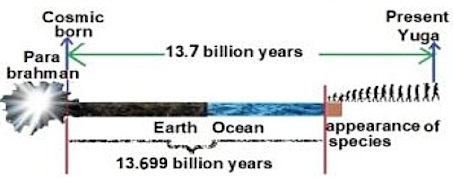
73. The undeveloped land and ocean was released by the Supreme and subsequently developed which took several billion years, to accommodate the humans. The Kula Devatha or Tutelary/Family deities therefore did not manifest immediately after the cosmic was released by ‘Supreme’ since the land was not made ready to accommodate the humans. Kula Devatha or Tutelary/Family deities were needed only to guide and guard families in area specific assigned to them; hence, prime divines from whom the Kula Devatha or Tutelary/Family deities came out were delayed by millions of years after cosmic was born.
74. The second reason for non manifestation of the family /tutelary deities immediately after the divines were created after the land and ocean were made ready was to give ‘Supreme’ sufficient time to work out the shape and appearances of several thousands of divines needed, which he planned to get only through the first three prime divines.
75. Once the three male energies took the forms of Brahma, Vishnu and Rudra who was also known as Siva, three female energies too came out and took the roles in the name of Parvathi, Saraswathi and Mahalakshmi. The three male energies and three female energies then joined together as Shiva -Parvathi, Brahma-Saraswathi and Vishnu-Mahalakshmi. In order to protect the universe, the Supreme released several divines through those three pairs of divines in different periods of time in the vast land.
76. The three pairs of divines which manifested released several divines from their energies. which turned out to demi gods, celestials and innumerable divine elements in the name of guardian divines for lands, protector for clusters of humans and in several other names.
77. There are conflicting views on who manifested first to release several divines including demi, semi gods, celestials and spirits many of which turned into Kuladevatha/Family/Tutelary deities several centuries later. etc
• The Shaivites say that Lord Shiva is supreme from whom the other two divines emerged. (Ref: Linga Purana, Chapter-3)
• The Vaishnavites say that Lord Vishnu appeared first from whom the other two divines emerged. (Ref: Narayana Suktham of Yajur Veda and Narayana Upanishad)
• The third view has been that Lord Brahma appeared first from the Cosmic Egg broke by ‘Supreme’ after which the other two divines emerged.
• The fourth view –Shaktism- says that matter came first as the Goddess, and from her came the mind, releasing three male forms: Brahma, the priest; Vishnu, the king; Shiva, the ascetic (Ref: Shrimad Devi Bhagavata Purana and Tantric purana texts)
78. Whatever is said and believed, the basic fact that the three main male divines emerged from ‘Supreme’ were Lord Shiva, Lord Vishnu and Lord Brahma and from them only came several other divines from whom came Kula Devatha or Tutelary/Family deities much later in stages.
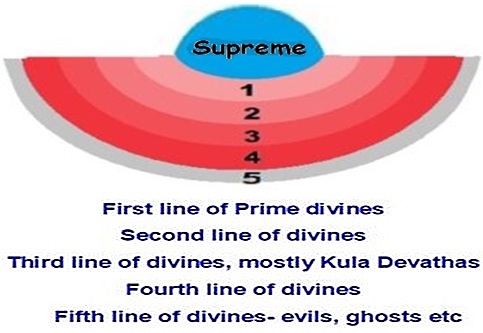
79. Thus, the Supreme created several layers of divines in the following order:
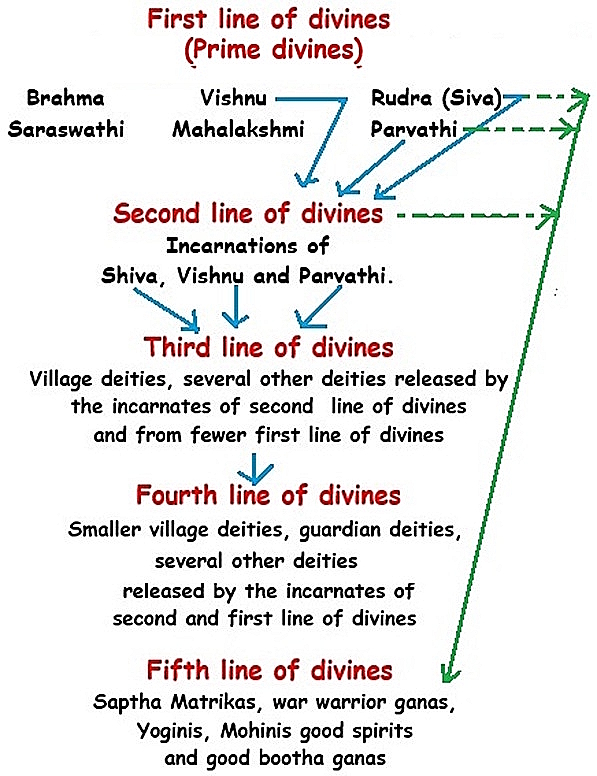
(a) First line of divines- Prime divines manifested like Brahma, Vishnu and Rudra (Siva), Parvathi, Saraswathi and Mahalakshmi. It is Claimed that Brahma was released from the divine energies of Vishnu. It is also claimed that even Saraswathi and Mahalakshmi were incarnates of Parvathi only.
(b) Second line of divines: Several incarnations of Shiva, Vishnu and Parvathi. Other three divines like Mahalakshmi, Brahma and Saraswathi did not release any other divines from them. Only Mahalakshmi has taken different incarnations of her own, but did not release and sub divines from her energies, because she herself emerged from the divine energies of Parvathi and hence, any release of divines from her goes into the act of Parvathi only.
(c) Third line of divines: Village deities, several divines released by the incarnates of second line of divines and even from fewer first line of divines especially during the war waged against evil forces.
(d) Fourth line of divines such as smaller village deities, guardian deities, good spirits and good bootha ganas.
(e) Fifth line of deities such as Yoginis and Mohinis to help tantra worship, meant for certain sadhanas, sadhus and sannyasins who desired to heighten their spiritual knowledge.
80. Out of six prime divines who emerged from Parabrahman, why only Lord Shiva, Lord Vishnu, and Goddess Parvathi were authorised to release deities of several in nature including Kula Devathas?
81. Students and teachers cannot function in the same manner; each have their own restrictions. Brahma, who has been assigned the task of creation in the universe, releases various living beings and humans with cycles of birth-death and rebirth who were akin to students entering into an educational institution to learn the process of life. Since he can not create various aspects of humans alone, he does that work with the knowledge and wisdom received from Saraswati, who is the goddess of wisdom and knowledge. Since the living beings created are in the nature of students, they are to be guided by various deities who act like teachers. Since Brahma creates various aspects of mankind who were students, he was not authorised to create teachers, who carry entirely different aspects, the one which can be gained only from an experienced divine like Vishnu.
82. Once the Supreme created the universe, made ready vast land and ocean, he engaged divines for the creation of mankind, protect those created and destruct evils in them. The big task lay before Vishnu, the protector was how to protect and guide the mankind by acting like a teacher, so that they could be driven into the path of leading life of morality and honesty. Only then there would be peace and prosperity in the vast land for long period of time. This is where the concept of Kula Devatha or Tutelary /Family deities emerged.
83. Brahma’s creations were mixed bag of good and evil minded besides Asuric (demonic) forces like undisciplined students. Due to their inborn qualities of evilness, naturally the evil would refuse to mend their ways easily and similarly the Asuric forces would continue to terrorize the folks of the land who needed to be eliminated from the universe like students getting rusticated from the university.
84. Vishnu realized that while at one end if he had to act like a teacher to guide and guard the folks a fleet of divines will be necessary, on the other end the evils need to be identified and pushed to face punishment under the long process of divine law for which another set of divines will become necessary. Those acts will be the responsibility of several divines in the 3rd, 4th and 5th line of divines to be generated much later. Many of them will turn out to be Kula Devatha much later. One of the most important Kula Devatha released by Vishnu was Lord Venkatachalapathi who became not only Kula Devatha to many who adapted him, but also those families whose Kula Devatha remained unknown to them.
85. Unless those who are born meet death, there would be no space available to accommodate additional creations or even the existing creations. Since Shiva alone cannot perform the act of destruction in the vast universe, he has to perform this act with the help of fewer divines to be created or authorized by him aided by his counterpart Parvathi. Many of the divines created by them too will turn out to be Kuladevatha/Family/Tutelary deities much later.
86. Act of destruction is of two kinds. Physical elimination and removal of Ignorance by bestowing wisdom to tread the path of spirituality and to get freed of sins. In the act of physical elimination, Shiva ensured that the act was carried out by one of the energies released through him, in the name of Yama.
87. Shiva and Parvathi- released several divine forces from their divine energies to not only fight and destroy the evil forces physically but also to destroy ones ignorance in the vast land . They included warrior divines too. Divines of various aspects thus released by them together included Mahishasura Mardini, Lalithambigai, Maha Kali, Nava Durga Devis, Dasa Mahavidya Devis, and Mariamman etc. Many of the divines thus released by the duo become Kula Devatha or Tutelary/Family deity much later.
88. Whenever the Asuric (Demonic) forces surfaced, Shiva either released several divine forces from him to engage and destroy the evil forces from the universe or he transferred his divine energies to other divines to destroy the evil and Asuric forces on his behalf. Many of the divines thus released by him included important divines such as Muruga, 64 Bhairava and Bhairavis, Veerabhadra, Sharabha, Ashwathama etc to destroy asuric forces. Some of them became Kula Devatha or Tutelary/Family deity later.
89. It will be interesting to know that all the divines released by Shiva did not become Kula Devatha or Tutelary/Family deities. They were meant to bestow wisdom to remove ignorance of folks such as Muruga in different manifestations, Dakshinamoorthi, Bhairava etc. However, an important deity created by Shiva was Lord Vaitheeswaran who became the Kula Devatha or Tutelary/Family deity for many folks besides those whose Kula Devathas were not known to them.
90. This is how broadly how the divines appeared along with semi, demi divines which turned into Kula Devatha after several thousands of years. As previously said huge fleet of divines became necessary to guide and guard the folks on the vast land. It became necessary to segregate them into several groups of divines which needed to be created. Areas were to be earmarked for each divine so that there will be no clash of interests among them in future.
91. Once the broad-based principle on creation of divines were worked out by the Supreme next bigger question was creation of humans for whom the divines were needed.
92. Supreme while creating the vast land and ocean fixed in the mind of Brahma, the initial land size and ultimate size of land, no of souls which can take birth in different appearances and forms, how the souls will generate souls after souls and how all of them get destroyed after specific no of souls get created etc. Supreme also laid down how many divines of different natures are to appear, what will be their form and appearance in the vast land so that the souls which gets converted as human or other creatures can be guided and guarded and destroyed from time to time.
93. This is how the vast land created by the Supreme will gradually expand :
• Supreme will release vast land
• Land and Ocean will be developed
• Prime divines to be created by Supreme
• Several secondary, third line, fourth line and fifth line divines will be
planned
• Brahma will begin act of creation
• Brahma planed evolution in four stages like Satya Yuga, Tretha Yuga,
Dwapara Yuga and Kali Yuga
• Yuga wise creations worked out vis a vis, the destruction of created
calculated
• Brahma will create seven Maharishis
• Maharishis will train on complete plan of action
• Parabrahman will rehearse the creation for several thousands of years and train the Maharishis on each aspect in four dummy yugas
• humans and other creatures will appear
• divines will appear in land
• Kula Devathas will emerge
94. Brahma realized that entire souls can not be released in one go and gradually they will have to be released in stages. He also realised that the no of divines needed in each plane is to be released in coordinated manner by his colleague divines. Therefore, Brahma divided the period of creations and destruction to take place in four stages called Satya, Tretha, Dwapara and Kali Yugas.
95. Brahma realized that the vast land across the universe would have to be expanded gradually beginning with Satya Yuga. The decision of Brahma to expand the land space was meant to accommodate increased populace who would get birth from the souls wandering in the floating plane which will alter the strength of souls from X quantum in first Yuga to say 2 x quantum in next yuga, 3 x quantum in the next yuga and so on. He took into account how much of those born will meet death, how much will get destroyed or their life span will come to an end etc in gradual stages. He thus, worked out the characteristics of the land accordingly. He was aware that no of divines to appear in each yuga should also be proportionate to the populace which will exist in each yuga.
96. According to Garuda Purana, initially Brahma created only 84 lakhs. If we properly understand the Garuda Purana text, which is stated to be the most authentic text in Hinduism, Brahma created 84 lac souls per Deva Year (God Year) in Satya Yuga. One Deva year accounts to 306 human years for Brahma. The life of Satya Yuga was 1,728,000 human years which is equivalent to 4800 Deva Years. Thus, the total no of active souls created in Satya Yuga at the rate of 84 lac per Deva year, could have been 403.200 million which may have included all creations like humans and animals and other creatures which had active life in them.
97. As per Garuda Purana, out of 84 lakhs created by Lord Brahma, 21 lakhs came from eggs, 21 lakhs from tree and plant vines, 21 lakhs from humans and mammals, and the remaining 21 lakhs were from worms and insects. This means only 25% of the souls initially created by him would have been in human form. Based on this information we can conclude that in Satya Yuga, out of 403.200 million souls created by Brahma, hardly 100 million souls may have been humans. However, how much divine forces were released simultaneously is not made known in any puranic texts or even folk lores.
98. Brahma did not fill the vast land with souls instantly after he began creation. First he created seven rishis for specific acts to spread divinity in the vast land. There are contradictions on the first batch of Hermits- Seven Rishis- created by Brahma. The Vedic school of thoughts, Jaiminiya (The Jaiminiya Upanishad Brahmana –जैमिनीय उपनिषद्-ब्राह्मण) mentions the list as Agastya, Atri, Bharadwaja, Gautama, Jamadagni, Vashishta and Vishwamitra, while another principal text called Brihadaranyaka Upanishad mentions same list but listing the seventh hermit as Brigu instead of Agastya. Similarly, the names of seven hermits vary in other principal texts of varying schools of thought.
99. One of the principal reasons for the creation of seven Rishis by Brahma was to categorise the entire human population under seven groups or Kulas, each Kula representing one of the seven Rishis initially created. The Kula represented the family of persons or descendants of a family related by blood. Therefore, the entire descendants of each Kula will have single distinctive Gothra representing one of the Saptha Rishis. Here again we find that in some caste they have more Gothras and thus over 2500 Gothras are reportedly existing in the universe.
100. Brahma, though created seven highly knowledgeable Maharishis and arranged to bring out many divines from the body of ‘Supreme’, he perhaps did not activate them in the land immediately and took time to first allow things to settle down in each of the four Yugas and rehearsed everything in the first few Yugas.
……….101 continued
References to all these points in last part

